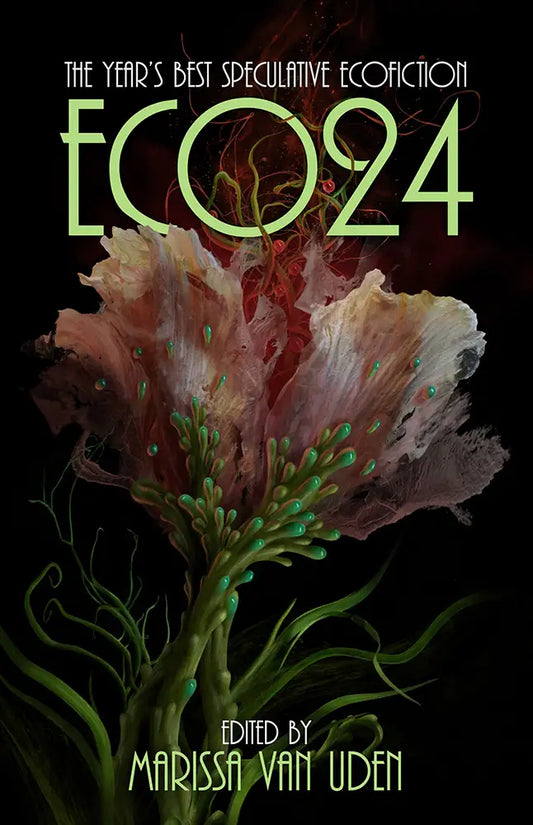
Welcome to another Words for Thought! Even though Spring is in full bloom, the stories in this column tend toward darkness and horror. They are stories of tension, isolation, family, loss, and being seen. They all use the lens of horror and darkness to tell us something about the human condition, and they do it beautifully and poignantly. Fair warning, there are some spoilers if you haven’t read these stories yet.
“Buddy Raymond’s No Bull-Shit Guide to Drone Hunting” by Gillian Secord, published in Diabolical Plots, starts off with a deceptively light tone. Set in a world where the United States has taken over the continent of North America, the story adopts the folksy voice of the author of a pamphlet offering Canadians advice on fighting back against American drones.
Hey, kid. Ol’ Buddy here, your favourite underground, pamphlet-writing canuck. I hope, whoever and wherever you are, you’re well. Keep the generator full, the firewood chopped, and the contraband hidden.
While the story could have been goofy or cutesy, Secord perfectly paces the gradual reveal of information, uncovering the grief at the story’s heart. Interspersed with the advice Buddy doles out, his personal history with drones comes to light, delivering an emotional gut-punch.
The story packs a lot into just a few thousand words. The voice is charming and doesn’t overstay its welcome, and the initial lightness counterbalances the heavier themes of loss—both loss of freedom, and loss of life. Another place where the story really shines is the grounding details that Secord works in throughout, giving a fully realized picture of the world and the characters, lending the story even more emotional weight. It’s not easy to pull off a story that feels so complete and satisfying at a relatively short length, but Secord does it masterfully.
“Just You and Me, Now” by KT Bryski, published right here in Apex Magazine, is a story that deals with loss and family in a different way.
The campsite looks like it wants to eat them. A fire pit yawns in the middle, an ashy-prey mouth ringed by rocks like rotting teeth. The trees crowd in, sizing them up, knifing the daylight. One gulp of that smoke-and-pine air, and Henry shudders head to foot.
Henry would rather be at soccer camp, but his parents have decided on a family trip instead. They wake to find their car vanished from their campsite, and when Henry’s father and older brother try to make their way to the camp office to report it, they find themselves right back when they started. A mysterious, silent stranger appears at their fire that night, and from there, things only get worse as Henry’s family members vanish one by one.
Bryski does a wonderful job of suffusing the story with tension and a sense of claustrophobia, despite being set outdoors. There’s a hostile world beyond the borders of the campfire, and darkness creeping in. The story is eerie, and the feeling of powerlessness and desperation is heightened by the fact that no explanation is offered for the events that unfold. The food is replenished every day, but the family can’t leave. The stranger doesn’t overtly threaten them, and yet he is a threatening presence lingering over everything. It’s an effective piece of horror that perfectly captures an inevitable sense of dread and a grim situation with no escape.
“Median” by Kelly Robson, published at Reactor, similarly captures a sense of dread and helplessness. Carla’s car breaks down as she’s on her way to work, leaving her stranded on the median of the 401.
She climbed to her feet and waved at an oncoming car. One of its headlights glinted in the sun. The driver turned his head as he passed, mirrored sunglasses square on her, but he didn’t slow. The other drivers didn’t even look at her. The truck drivers stared straight over her head.
In addition to not being able to flag down any passing cars, Carla can’t get through to 911, or to anyone else. Calls begin coming into her phone from desperate people begging for her help—people like her who are stranded, powerless, and alone.
Like Bryski’s story, Robson’s is soaked in tension and fear. There’s a visceral sense of cars sweeping by, blowing grit and buffeting Carla with their speed. There’s a growing sense of isolation as Carla tries to make anyone see her, and a sense of being trapped and unable to help anyone else. Her world is small, like the world in Bryski’s story, with the same claustrophobic vibe of being hemmed in while being outdoors. At the same time, Robson uses the horror of the situation to explore the idea of being seen—the motorists who look through or away from Carla contrasted with Carla’s attempt to offer comfort to the people who call her, even though there’s nothing she can physically do to help them. Sometimes people just need to know they’re not alone, and in the end, “Median” is a story about choosing kindness and caring in a situation where it was be easier to turn bitter and give up.
“First Girls” by Jessica Luke García, published in Nightmare Magazine, also explores the theme of being seen. As the title implies, this flash piece takes a look at the slasher trope, specifically the girls who die first in horror movies.
We are the sluts who writhe beneath jockish hips in the woods, nails clawing, tongues heavy. We taste like plastic lip gloss, Mike’s Hard, hot sex. We’re the sneak-through-the-window teenage sleepover best friends.
Various slasher tropes have been deconstructed and examined across literature and media. Much has been made of final girls, but less often do we see the perspective of the first girls, usually because they are dead and voiceless.
García makes good use of the collective voice to invite the reader into these girls’ point of view. They are unapologetic regarding their sexuality. They adopt masks in order to move through the world. They are self-aware, including understanding that their choices are limited, they have a role to play, and they are a cautionary example in someone else’s story. Along with exploring the sharp dichotomy of roles available to girls in traditional slashers—sluts who die, or virgins who survive—the story, like Robson’s, also explores the idea of being seen. Along with whatever else they may be, these first girls want to be acknowledged and remembered. They may not be the heroes of their stories, but that doesn’t make them weak, deserving of their fate, or mean that they are willing to be cast aside. They have a different kind of strength, and they demand to be recognized. The story packs a lot in at flash length, and it’s effectively done.
“Stitched to Skin Like Family Is” by Nghi Vo, published in Uncanny Magazine, is another story featuring the voices of ghosts who want to be recognized. The protagonist hears memories through clothing as she mends it—shirts and jackets and trousers giving her insight into the lives of the people who own them. She also hears the voices of the dead, including her family, who urge her on in her search for her missing brother, Yongjun.
My suitcase in the back, little coffin, chuckled with voices long dead, and we drove into the late afternoon.
She tracks down the boarding house where her brother was staying, and through the clothing she finds there discovers that the family who runs it are serial murderers. They attack her as well, but she’s able to escape with the help of shoes and jackets and shirts, reuniting her brother with the rest of her family by laying out their clothes together.
The story is simultaneously sweet and painful as it explores loss, grief, and the way we carry memories in the things kept closest to us, including our clothes. It’s also a story about perception—what the clothes we choose to wear say about us, and how we present ourselves to the world versus our true selves. The protagonist is perceived a certain way as a woman of color, and presents herself a certain way as a defense mechanism. The seemingly kind family who sing spirituals at dinner are ruthless killers, but because they are white and present themselves as godly, they remain above suspicion. The story is well done and offers a nice balance between hope and horror.












